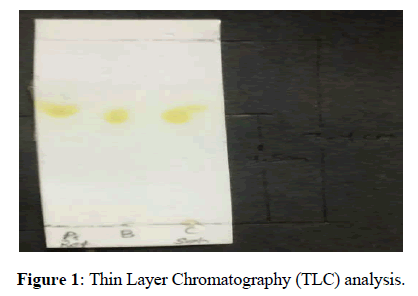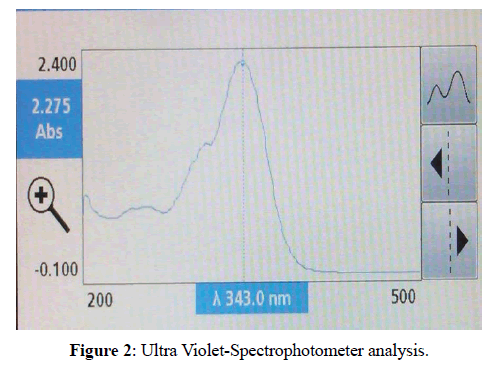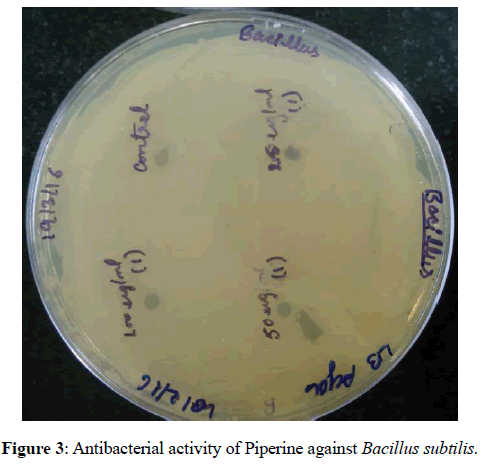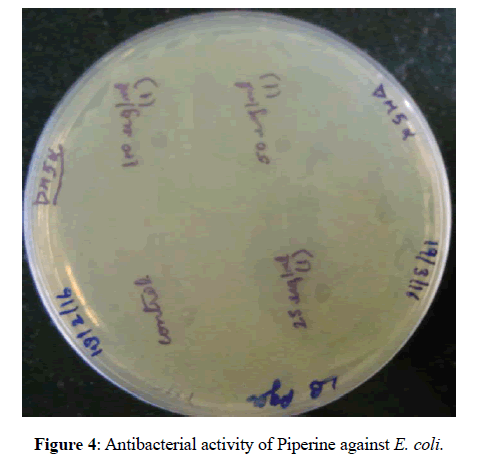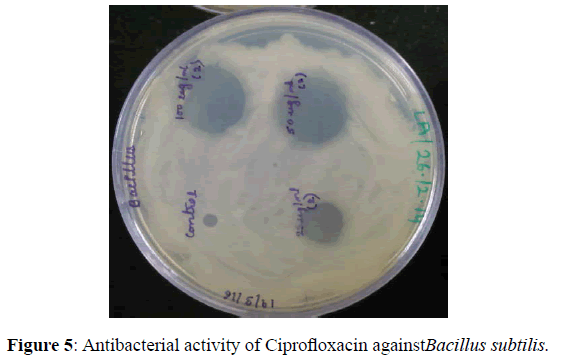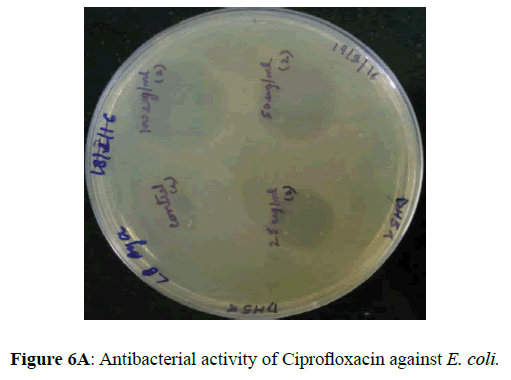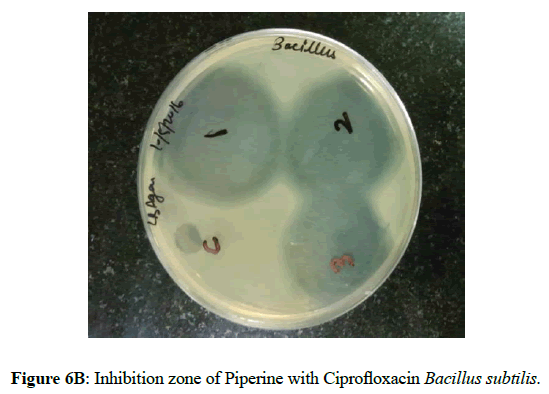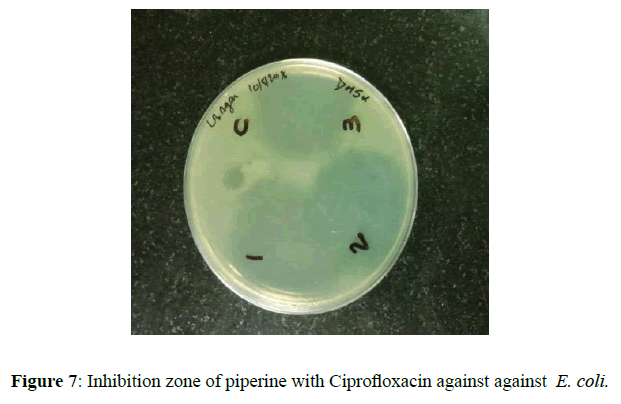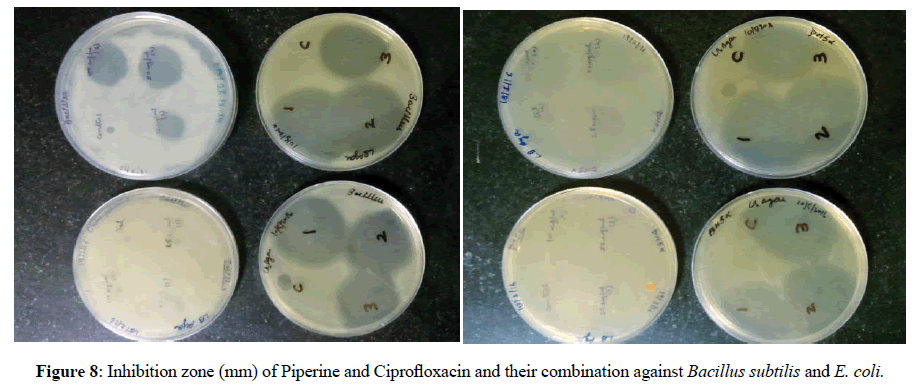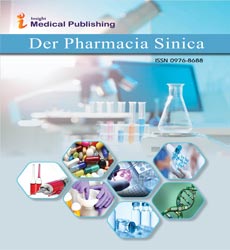ISSN : 0976 - 8688
Der Pharmacia Sinica
Synergistic Effect of Piperine, Extracted from Piper nigrum, with Ciprofloxacin on Escherichia coli, Bacillus subtilis
Jaya Maitra* and Shilpi
Department of Applied Chemistry, School of Vocational Studies and Applied Sciences, Gautam Buddha University, Greater Noida, Uttar Pradesh - 201310, India
Abstract
The purpose of the present study is to determine the antibacterial activity of Piperine extracted from Piper nigrum and its synergistic effect with antibiotic drug (Ciprofloxacin) against Escherichia coli and Bacillus subtilis. The research targets expensive, toxic drug inputs that exhibit poor bioavailability with easily available, non-toxic, natural plant extracts for similar/improved outcomes. Piperine was extracted from Piper nigrum. The antibacterial activities of this extract were evaluated using the drug inhibition zone formation assay. The inhibitory zones were recorded in millimeters. Combinations of Ciprofloxacin and Piperine have shown synergistic activity against both the organisms. Extracted Piperine from Piper nigrum was active against Bacillus subtilis and E. coli even at a very low concentration (20 μg/mL) in combination with Ciprofloxacin.
Keywords
Piperine; Antibacterial activity; Ciprofloxacin; Synergism
Introduction
The global impetus is now on developing methods, which enhance the bioavailability of drugs, reduce the drug dosage and cost of treatment. Ayurveda synergised with modern methods of drug research is directed towards developing potent, lower dosage and economically viable drug combinations. Drawing on the hypothesis of ‘Trikatu’ in Ayurveda which has three ingredients: Black Pepper (Piper nigrum), Long Pepper (Piper longum) and Ginger (Zingiber officinale), it has been found that one of the ingredients i.e. ‘Piperine’ has increased the bioavailability of many drugs [1-3]. The addition of bio-enhancer reduced drug dosage, reduced cost of the drug, reduced the incidence of drug resistance and reduced the risk of adverse drug reaction/side effects.
Piperine is the major alkaloid present in black pepper belonging to the family Piperaceae, which is responsible for its hot and spicy taste. It has anti-inflammatory, analgesic, anti-arthritic, CNS depressant, anticonvulsant properties [4-7]. Piperine is the first and most potent bio-enhancer [8]. Piperine, the active principal present in Piper nigrum is isolated and its bioavailability enhancing action was established [9,10]. It increased the bioavailability of many drugs Barbiturates, Coenzyme Q10 (CoQ10), Curcumin (extract from turmeric), Dapsone, Ethambutol, Atenolol, Phenytoin, Propranolol, Pyrazinamide, Rifampicin, Ampicilin, etc. Piperine has reduced the dosage, cost and toxicity of rifampicin [11-14]. Piperine was found to increase the bioavailability of several classes of drugs including antibacterial, antifungal, anti-inflammatory, anticancer, antitubercular, analgesic, leprosy, antibiotics, and CNS drugs ranging from 30 to 200% [15,16].
Materials and Methods
To find the Synergistic Effect of Piperine with Ciprofloxacin against Bacillus subtils, E. coli following materials and method are adopted.
1. Black paper was taken from local market: All reagents are of analytical grade (CDH).
2. Bacteria: Non-Pathogenic strains of Bacillus subtilis, Escherichia coli were obtained from Biotechnology Department (Microbiology Lab) of (Gautam Buddha university) and were maintained on agar medium (HiMedia) at 4ºC for further experiments.
3. Culture media and chemicals: Nutrient agar (Biolife) and Mueller-Hinton agar (HiMedia) were used for carrying out the experiment. Ethanol and methanol were used for extraction process.
4. Antibiotic drug, Ciprofloxacin was taken.
Piperine was isolated from Piper nigrum by Soxhlet using ethanol as a solvent. Isolated Piperine was evaluated by UV absorbance and TLC.
I. Extraction of piperine from pepper powder: The powdered black pepper (10 gm) with 95% ethanol (150 ml) was extracted in a Soxhlet apparatus for 2 h. The solution was filtered and concentrated in vacuum on a water bath at 60ºC. 10 ml of 10% alcoholic KOH was added to the solution and extract was decanted and after a while the insoluble was obtained.
II. Identification of piperine:
(a). Thin Layer Chromatography (TLC) Analysis
Sample details: Piperine
Adsorbent: Precoated Silica gel
Solvent system: Acetone: n-Hexane (35:15)
Sample preparation: Piperine (1 mg) was dissolved in ethanol (1 ml) and this solution was applied on the TLC plate with the aid of capillary tube.
Detection: Saturated Iodine Chamber.
Procedure: The piperine was subjected on to the precoated and activated Silica gel TLC plates. (Plates were kept in oven for 1hr at 70°C). The mobile phase is Acetone: n-Hexane in 35:15 ratios. After the TLC run and spraying the detecting agent yellow sports of piperine were identified visually. Rf value was calculated. Rf- value = 4.5/7.4=0.61 (Figure 1).
(b). Ultra Violet-Spectrophotometer Analysis: The 0.01% w/v solution of piperine in methanol was prepared and λmax was determined (Table 1 and Figure 2).
| Λmax | Absorbance |
|---|---|
| 343nm | 2.2275 |
Table 1: UV spectrophotometer analysis
Drug inhibition zone formation assay: The bacterial cultures were grown in LB Agar at 37ºC. After 4 h of growth, each bacteria was inoculated on the surface of LB agar plates. The bacterial inoculum in each well was 5 × 105 CFU/ml. Different concentration of Piperine, Ciprofloxacin and their combination were taken to study the antibacterial activity against Bacillius subtilis, E. coli (Tables 2-4).
| S. No. | Name of the bacteria | Conc (μg/mL) | Zone of inhibition (mm) |
|---|---|---|---|
| 1. | Bacillus subtilis | 10 50 100 |
3 4 7 |
| 2. | E. Coli | 10 50 100 |
2 3 5 |
Table 2: Inhibition zone (mm) Piperine against Bacillus subtilis, E. coli, at different concentration
| S. No | Name of the bacteria | Drug | Conc (μg/mL) | Zone of inhibition (mm) |
|---|---|---|---|---|
| 1. | Bacillus subtilis | Ciprofloxacin | 10 50 100 |
10 15 18 |
| 2. | E.coli | Ciprofloxacin | 10 50 100 |
14 18 20 |
Table 3: Inhibition zone (mm) of Ciprofloxacin against Bacillus subtilis, E. coli
| S. No. | Name of the bacteria | Combination of drugs with Piperine | Conc. of Piperine (μg/mL) |
Conc. of Ciprofloxacin (μg/mL) |
Zone of inhibition (mm) |
|---|---|---|---|---|---|
| 1. | Bacillus subtilis | Piperine + Ciprofloxacin | 20 50 100 |
15 10 5 |
40 41 44 |
| 2. | E. coli | Piperine + Ciprofloxacin | 20 50 100 |
15 10 5 |
38 40 42 |
Table 4: Antibacterial activity of combination of Piperine with Ciprofloxacin against Bacillus subtilis, E. coli
The plates were incubated at 37ºC for 24 h. The diameters of clear zones were measured.
The antibacterial activity of Piperine against Bacillius subtilis, E. coli. (Figures 3 and 4).
i) The antibacterial effect of Piperine is shown in Table 1. It indicates that zone of inhibition increases as the concentration of Piperine increased. Piperine has shown an antibacterial activity against gram-positive and gram-negative bacteria with zone of inhibition ranged from (2 mm-7 mm). The maximum zone of inhibition against gram-positive bacteria Bacillus subtilis was (7 mm) and for gram-negative bacteria E. coli was 7 mm.
ii) The antibacterial activity of Ciprofloxacin against E. coli, Bacillius subtilis (Figures 4, 5 and Table 2, 3). The antibacterial effect of ciprofloxacin is shown in Table 2. It indicates that zone of inhibition increases as the concentration of drug increased. Ciprofloxacin has shown an antibacterial activity against gram-positive and gram-negative bacteria with zone of inhibition ranged from (10 mm-20 mm). The maximum zone of inhibition against gram-positive bacteria Bacillus subtilis was (18 mm) and for gram-negative bacteria E. coli was 20 mm.
iii) Synergistic effect between plant extract of Piperine with Ciprofloxacin drug against Bacillus subtilis and E. coli (Figures 6-8 and Table 4).
There was remarkable increase in the (ZOI) when ciprofloxacin (15 μg/ml, 10 μg/ml, 5 μg/ml) was taken in combination with piperine (20 μg/ml, 50 μg/ml and 100 μg/ml) against Bacillus subtilis and E. coli. The bacterial inoculum in each well was 5 × 105 CFU/ml. The plates were incubated at 37ºC for 24 h. (Table 3 and Figure 6A, B). The dose of Ciprofloxacin was reduced because of its toxicity.
i) Against Bacillus subtilis: As shown in Table 3 and Figure 5, extracted Piperine with combination of Ciprofloxacin antibiotic had the highest inhibition zone (44 mm).
ii) Against Escherichia coli: Showed the highest inhibition zone against E. coli (40 mm) in (Table 3 and Figure 6), extracted Piperine with combination of Ciprofloxacin antibiotic drug.
Result
The results of this study were encouraging and revealed the importance of piperine when associated with antibiotic drug in control and treatment of bacterial infection.
Conclusion
Combination of Piperine with Ciprofloxacin drug will broaden the antibacterial spectrum of either and will achieve synergistic outcome. Black pepper contains approximately 5-9% Piperine and currently listed by FDA as a ‘safe herb’ for its intended use as spice. The results indicate that optimal combination of Piperine with Ciprofloxacin can lead to reductions in drug dosage with a cascading beneficial influence on the drug treatment ecosystem.
References
- Zutshi, R.K., Singh, R., Zutshi, U., et al., J Association of Physicians of India, 1985. 33: p. 223-224.
- Atal, C.K., I.D.M.A. Bulletin, 1979. 10: p. 483-484.
- Johri, R.K., Zutshi, U., J Ethnopharmacology, 1992. 37: p. 85-91.
- Bang, J.S., Oh, D.H., Choi, H.M., et al., Arthritis Research and Therapy, 2009. 11: p. R49.
- Sudjarwo, S.A., Folia Medica Indonesiana, 2005. 41: p. 190-194.
- Evan, W.C., W.B. Saunders London, 1997. 14: p. 363-364.
- Deepthi, S.P., Junis, V., Shibin, P., et al. Der Pharmacia Letter, 2012. p. 863-868.
- Acharya, S.G., Momin, A.H., Gajjar, A.V., Am J Pharmtech Res, 2012. 2: 2249-3387.
- Atal, C.K., Zutshi, U., Rao, P.G., J Ethnopharmacology, 1981. 4: p. 229-232.
- Bhojwani, H.R., Aggarwal, O.P., Millennium R and D Management Conference Leveraging Research and Technology, 2000. p. 30-31.
- Zutshi, R.K., Singh, R., Zutshi, U., et al. J Association of Physicians of India, 1985. 33: p. 223-224.
- Janakiraman, K., Manavalan, R., International J Pharma Sci Res, 2011. 2: p. 1176-1181.
- Lee, E.B., Shin, K.H., Woo, W.S., Archives of Pharmacal Res, 1984. 7: p. 127-132.
- Atal, N., Bedi, K.L., J Ayurveda and Integrative Med, 2010. 1: p. 96-99.
- Bano, G., Raina, R.K., Zutshi, U., et al. Eur J Clinical Pharmacology, 1991. 41: p. 615-617.
- Khan, I.A., Mirza, Z.M., Kumar, A., et al. Antimicrobial Agents and Chemotherapy, 2006. 50: p. 810-812.
Open Access Journals
- Aquaculture & Veterinary Science
- Chemistry & Chemical Sciences
- Clinical Sciences
- Engineering
- General Science
- Genetics & Molecular Biology
- Health Care & Nursing
- Immunology & Microbiology
- Materials Science
- Mathematics & Physics
- Medical Sciences
- Neurology & Psychiatry
- Oncology & Cancer Science
- Pharmaceutical Sciences
